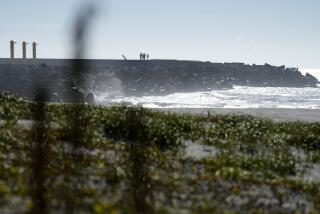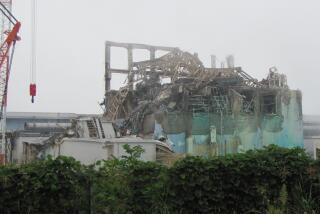Radioactivity surges again at Japan nuclear plant
- Share via
Reporting from Tokyo and Los Angeles — Radiation levels increased sharply inside and outside the Fukushima Daiichi nuclear power plant Thursday, slowing work on the devastated facility again and once more throwing into doubt the integrity of the containment vessels that hold the fuel rods.
Tokyo Electric Power Co. officials said the level of radioactive iodine in water at the plant hit levels 10,000 times the permissible limit, preventing workers from getting near the water, which accumulated during early efforts to prevent a full-fledged meltdown by flooding the plant.
Engineers have been pumping water out of basement tunnels in the reactor buildings and into holding areas in an attempt to give workers access so they can try to restore electricity to the cooling pumps that could ultimately bring the crisis under control. But they cannot do so when radiation levels are that high.
The iodine is the primary gaseous byproduct of fission of uranium in the fuel rods that produce the power from the plant. Its presence in water suggests that, at the very least, the encasing around the uranium fuel pellets has cracked, permitting the gas to escape. The good news is that radioactive forms of iodine have a half-life of about an hour for one isotope, and eight days for the other, so the radioactivity should quickly decay if no further release occurs.
Engineers speculated that the radiation surges may be coming from a partial meltdown of the fuel core of reactor No. 1. It appears that small segments of the melted fuel rods in that reactor are undergoing what is known as “localized criticality,” emitting brief flashes of heat and radiation.
The level of radioactive iodine in seawater off the coast at the plant has also risen, according to Japan’s nuclear safety agency. The Nuclear and Industrial Safety Agency said Thursday that the amount of the isotope in water about 350 yards off the coast had increased to 4,385 times the permissible level, up about a third from the previous day’s level.
The agency said the seawater level of cesium-137, a much more dangerous isotope because its half-life is more than 30 years, was about 527 times the permissible level. Environmental experts fear that the cesium could get into plankton and then into fish, where it could make its way along the food chain to humans.
Fishing is not allowed within 12 miles of the plant, and radioactive isotopes are expected to become diluted quickly in the vastness of the Pacific.
For the first time, Japanese officials said Thursday that they had detected radiation in beef from Fukushima prefecture — 510 becquerels per kilogram of meat, just over the national guideline of 500 becquerels per kilogram. The meat will be retested and will not be sold, authorities said.
Even as radiation levels are rising at the nuclear plant, public broadcaster NHK said Thursday that many workers at the facility do not have radiation monitoring badges. Tokyo Electric Power Co., known as Tepco, which owns the plant, confirmed the report, noting that most of the devices were destroyed in the magnitude 9 earthquake and subsequent tsunami that left 27,500 people dead or missing.
Company officials said only 320 monitors remained out of the 5,000 devices the company had before the disaster. But they said the leaders of each team of workers have a badge and that workers without badges are assigned to areas with low radiation risk. Tepco added that it may postpone low-priority work to minimize employees being on site without a monitor.
Concern over radiation may also be hampering recovery of bodies in the immediate area around the nuclear facility. Fukushima prefecture still has 4,760 people missing, and media reports suggest that authorities are hesitant to look for them for fear of radiation exposure.
Japan’s chief Cabinet secretary, Yukio Edano, said Thursday that the evacuation of residents near the stricken plant would be “long-term.”
The U.S. Department of Energy has sent about 40 people to Japan to help with the crisis, according to Peter Lyons, the department’s acting assistant secretary for nuclear energy. The French nuclear group Areva has sent five experts in decontaminating water.
On Wednesday, a 155-person Initial Response Force specially trained in handling nuclear emergencies was dispatched to Japan from the U.S. Naval Support Facility in Indian Head, Md.
Makinen reported from Tokyo and Maugh reported from Los Angeles.







